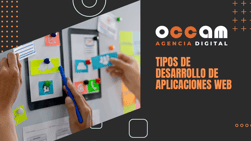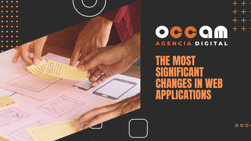Index Content
At Occam Digital Agency in Madrid we don't just program, we also analyse the needs of each client, we create a unique design and user experience (UX). Why? Simply because our main focus is on the client. That said, we develop APIs on average to make integrations with other systems and back office to digitise and automate processes. Do you need to design a custom application? Does your back office require a 360 degree turn? Follow us in this post and discover how we can help you.
Application design: from idea to result
Every design is born from an idea. Imagine that a client has a very general idea like this: to develop an application so that users can file complaints or reports to the local council. This idea will be refined and perfected from the beginning:
- is it an app for Android or iOS devices?
- will it allow geolocation from the users' current position?
- what type of user is it aimed at, for those with maintenance problems and municipal responsibility?
- will the application report on the situation of the municipality?
- what other options will it integrate?
- what functional aspects will it include?
- what is its business model?
- how will it be distributed and monetised?
- Budget and deadline.
- is there a similarapplication on the market?
- who will use it?
There are different points to take into account in the development of this type of mobile applications. All these steps can be summarised in the points we show you in the following section.
6 steps in the design of customised applications
The idea: the basis of your application. Nobody likes to walk on false ground, nor ambiguities. Imagining and dreaming is all very well, but when it comes to the development of mobile applications, you have to have your feet on the ground. One of the most complicated steps when creating our App is to define the idea and give it shape, as well as developing it at a technical and functional level.
First, you have to think about the operating system, the resolution, the screens, the adaptability, and then the representation of all these functions, operations and processes in the system. At Occam we have professionals with extensive skills, experience, knowledge and abilities. When the technical and functional levels connect, developers manage to create successful projects, turning the initial idea into a visible reality.
The idea can come from your imagination or derive from a consultancy with experts in customised technological solutions.
-
The briefing: When an idea is good, it has to be expressed in detail, we meet with the client to find out first-hand what he expects from us and the keys to the project: objectives, available budget, devices, operating system, potential audience, mobile strategy, theme of the App, monetisation, etc. All efforts must come together to achieve the dreamed results.
-
Planning: A goal without a plan is just a wish.
If there is no planning, there is no project. Our team pays special attention to this phase to lay all the foundations for the development of the application. We hold meetings to explain how we are going to work, what steps we are going to take and that each of the parties contribute solutions, ideas or points of view focused on achieving the final objective of the project. -
Application design: The visible and usable face.
It is not only a step to show off the aces up your sleeve. The design will be vital to attract more users to the application and increase downloads. If the client tests the final design and gives his approval, it is time to start creating the multimedia elements, make usability tests, create graphics, prototypes and everything you need to have the application ready. But design is not everything. -
Development: Let's get to work!
In this phase we are going to implement all the functionalities necessary for the application to work correctly. This is the time to think about performance, compliance with web accessibility standards, data security, databases, etc. The requirements that have been defined and the graphic flow of the application will help us to define a list of tasks that the programming team will develop. We will make progressive advances and we will show them to the client as the project is built until it is completed. -
Testing or pentesting. Configuration to go live.
When the programming of the application is completed, it is time for a series of technical tests in order to identify and solve problems. Afterwards, the final project is demonstrated to the client and joint tests are carried out to obtain feedback before its publication. -
Launch.
At this stage, we take care of configuring the application and preparing it for its subsequent launch. In the case of Google Play, the time that passes from submission to its appearance in the shop is 3 hours. This time is 3 days in the case of the App Store.
do you have an idea in mind and you don't know where to start? Ask for information and ask us all your questions. At Occam Agencia Digital we will be happy to help you and to embark on this journey together.




